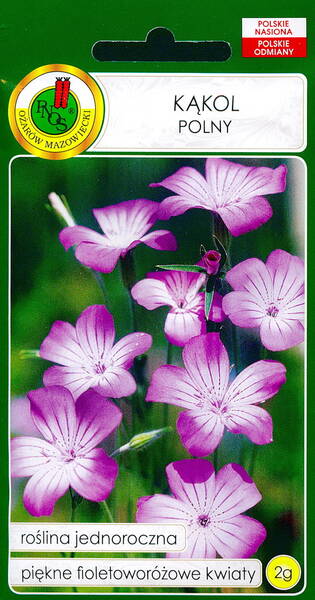Your shopping cart is empty!
Сorncockle
Common corncockle - Agrostemma githago.
A highly branched plant, up to 50 cm tall. The flowers are pale lilac, up to 7 cm in diameter, with a lighter center. Abundant flowering continues from June to the end of August. The flowers open in the morning and close in the afternoon. They love light and require a sunny location. They grow on light, calcareous, not damp soils. The seeds are sown in early spring in a permanent place. The seedlings are thinned out, leaving 15-30 cm between the plants. They are used in mixed plantings, flower beds, and sometimes for cutting. When cut, the plants stand in water for up to 7 days.
Name: comes from the Greek words "agros" - arable land and "stemmatos" - wreath, garland, which can be translated as a field wreath.
Unites 3 species of annual and biennial herbaceous plants common in the temperate climate regions of Europe and Asia. In floriculture, 2 species are used. In nature, it is found in Sicily.
An annual, highly branched plant, up to 50 cm high. Flowers up to 3 cm in diameter, light red, with a lighter center, resemble phlox flowers in shape, but are located singly at the ends of shoots, with abundant branching creating the impression of a loose umbrella. Abundant flowering continues from June to the end of August. Flowers open in the morning and close in the afternoon. It bears fruit well. There are about 1500 seeds in 1 g, they are small, 0.2 g is needed for 100 plants. Seeds retain their germination for 3-4 years. When cut, plants stand in water for up to 7 days.
Location: light-loving, require a sunny location. Drought-resistant, cold-resistant.
Soil: grown on light, calcareous, not damp soils.
Propagation: by seeds, which are sown in early spring in a permanent place, in nests of 3-4 seeds. If the soil warms up to a temperature of 12-16 °C, shoots will appear in 1-2 weeks. They are thinned out, leaving 15-30 cm between plants. They grow well when sown before winter.
Use: especially good in mixed plantings with cereal grasses, when the flowers flutter even with a slight breeze, like elegant butterflies. Looks good in a vase in country-style bouquets. In bouquets, it lasts up to 7 days.
Agrostemma is used for container culture, but it should be borne in mind that the plants need support. Lodging can be prevented with a thin wire ring. Attracts bees.
Partners: especially good with cereal grasses and in mixed plantings with other types of wild flowers.
A highly branched plant, up to 50 cm tall. The flowers are pale lilac, up to 7 cm in diameter, with a lighter center. Abundant flowering continues from June to the end of August. The flowers open in the morning and close in the afternoon. They love light and require a sunny location. They grow on light, calcareous, not damp soils. The seeds are sown in early spring in a permanent place. The seedlings are thinned out, leaving 15-30 cm between the plants. They are used in mixed plantings, flower beds, and sometimes for cutting. When cut, the plants stand in water for up to 7 days.
Name: comes from the Greek words "agros" - arable land and "stemmatos" - wreath, garland, which can be translated as a field wreath.
Unites 3 species of annual and biennial herbaceous plants common in the temperate climate regions of Europe and Asia. In floriculture, 2 species are used. In nature, it is found in Sicily.
An annual, highly branched plant, up to 50 cm high. Flowers up to 3 cm in diameter, light red, with a lighter center, resemble phlox flowers in shape, but are located singly at the ends of shoots, with abundant branching creating the impression of a loose umbrella. Abundant flowering continues from June to the end of August. Flowers open in the morning and close in the afternoon. It bears fruit well. There are about 1500 seeds in 1 g, they are small, 0.2 g is needed for 100 plants. Seeds retain their germination for 3-4 years. When cut, plants stand in water for up to 7 days.
Location: light-loving, require a sunny location. Drought-resistant, cold-resistant.
Soil: grown on light, calcareous, not damp soils.
Propagation: by seeds, which are sown in early spring in a permanent place, in nests of 3-4 seeds. If the soil warms up to a temperature of 12-16 °C, shoots will appear in 1-2 weeks. They are thinned out, leaving 15-30 cm between plants. They grow well when sown before winter.
Use: especially good in mixed plantings with cereal grasses, when the flowers flutter even with a slight breeze, like elegant butterflies. Looks good in a vase in country-style bouquets. In bouquets, it lasts up to 7 days.
Agrostemma is used for container culture, but it should be borne in mind that the plants need support. Lodging can be prevented with a thin wire ring. Attracts bees.
Partners: especially good with cereal grasses and in mixed plantings with other types of wild flowers.
Bot. syn.: Agrostemma gracilis Boiss., Githago gracilis (Boiss.) Boiss.












